Lunch with Lynne: Indian Scrambled Eggs and Paratha
My friend Lynne is a librarian. She loves books; in fact, she used to sell them. That’s one reason her book displays at the library are so good. She enjoys participating in book clubs, and gave me some tips about running book club meetings when the Dowdy Corners Cookbook Club was still just an idea. I would love to have Lynne in DCCC, but the thing is, Lynne likes to eat better than she likes to cook. So I’ve decided that a lunch with Lynne, featuring the food of the current DCCC cookbook, is a great way for Lynne to participate, Lynne style.
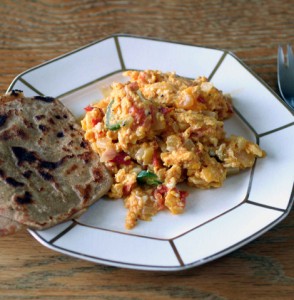 Luckily Lynne has an open palate and welcomes food made with fiery chili peppers—just so it’s not too hot. A few weeks ago, I had Lynne over for a lunch from the cookbook Entice with Spice: Indian Scrambled Eggs (Anda Bhurji) and Flaky Wheat Bread (Sada Paratha). Actually I had an ulterior motive when deciding to attempt homemade paratha for our lunch.
Luckily Lynne has an open palate and welcomes food made with fiery chili peppers—just so it’s not too hot. A few weeks ago, I had Lynne over for a lunch from the cookbook Entice with Spice: Indian Scrambled Eggs (Anda Bhurji) and Flaky Wheat Bread (Sada Paratha). Actually I had an ulterior motive when deciding to attempt homemade paratha for our lunch.
Making bread isn’t something that is second nature to me. I would love for the club to choose a bread baking book to force me to deal with my anxiety and become one with the bread. Until then, however, a recipe that looks like this:
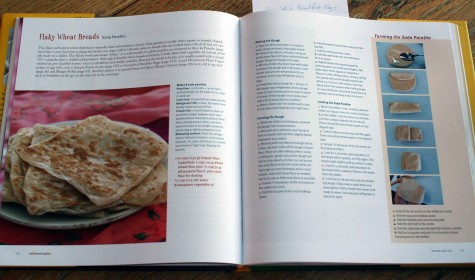 requires Lynne, the bread maker’s assistant.
requires Lynne, the bread maker’s assistant.
I decided that if Lynne read the steps to me while I rolled out the dough, folded it, floured it, etc., etc., that all would be okay. Here is Lynne reading, while I worked.

As it turned out, once we did a few of the breads, I lost my nervousness and enjoyed the rhythm of the process, which goes like this:
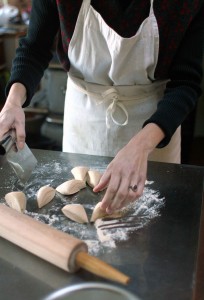
Divide the dough into eight sections.
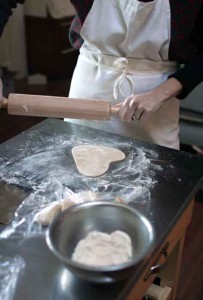
Form a section of dough into a ball, flatten it between your palms, and then roll it out to a 4-inch circle. (As you can see, my first try isn't exactly a circle.)

Spread on some oil.

Fold the top down to the middle, then fold the bottom up and over. This is Lynne giving it a try.
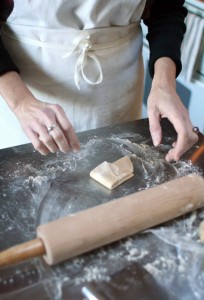
Then fold in one side.

And then the other.
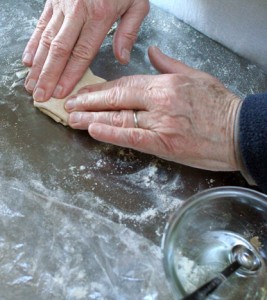
Flatten and then dust with flour. (Lynne again.)
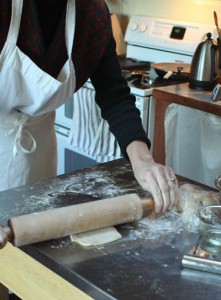
Roll a final time, keeping the square shape.
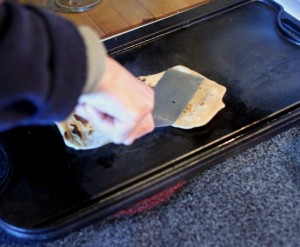
Cook on a hot griddle. (Pressing down on the bread, as shown here, is part of the cooking process.)
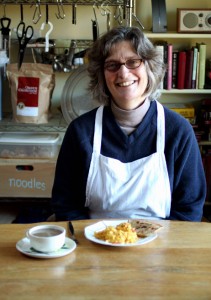
And eat. (From this shot, it looks like Lynne ate lunch alone. Next time I'll set up a tripod so that you can see that we really did enjoy the lunch together.)
The bread turned out nicely: the multiple folds give it a more tender quality than the everyday bread known as chapatti. Yet I think it is meant to be even tenderer than my first results. Less handling, I think, and practice, is the answer.
Made with diced onion and tomato, fresh green chili pepper, cayenne and ground turmeric, the colorful scrambled eggs were nicely spiced and very flavorful—a great way to wake up your taste buds in the morning! And they went perfectly with the bread. Having now made a few breads from Entice with Spice—I’ve also made the chapatti and tandoori roti—I’ve had a realization about Indian bread, and its role in an Indian meal. Taken on their own, the three Indian breads I’ve made, to my Western palate, taste bland because there is no salt in the dough. But when eaten with Indian food, which is always highly seasoned, it’s the perfect foil for the complex flavors of the food, and the bread no longer seems bland. (There are exceptions: Naan, a bread typically served in restaurants in India, does have some salt. And there are flavored breads and stuffed breads, but they, according to author Shubhra Ramineni, are more commonly eaten as snacks own their own rather than with other foods.)
I’m glad to have discovered this delicious Indian recipe for scrambled eggs. We have four laying chickens, so coming up with new ways to cook eggs is useful. There are two other egg recipes in Entice with Spice that I would like to try, but haven’t yet: Simple Egg Curry and Tamarind Egg Curry (Kodiguddu Pulusu). Both use hard-boiled eggs.
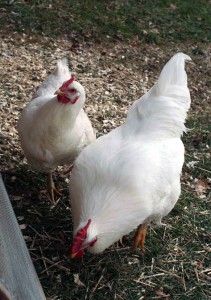
Ginger, one of our four hens, and Bob the Rooster, in the foreground. The domesticated chicken is a descendent of wild jungle fowl from Northeast India.
I may have to hold off on the egg curries until the Spring when the chickens pick up their egg-laying pace again. Chickens are affected by light and lay fewer eggs during the shorter days of winter. Plus our new pullets haven’t started to lay yet. (Although, Bob the Rooster has already had his way with them. Mike’s thought: If you can get laid, shouldn’t you be laying?) The pullets replaced two of our original hens that were lost to a fox, it is presumed. And our current rooster is technically Bob#2, replacing the original Bob who was also lost to a fox.
Eggs that are to be hard-boiled should be at least a week old. If they are too fresh, the peel won’t come off easily and you’ll end up peeling chunks of the egg away as you try to peel it. Wasteful and frustrating. I didn’t learn this until befriending some rural-type people in Vermont who know about such stuff. (This is not a concern with eggs from the grocery store.) Because the egg production is low right now, we simply don’t have eggs around the house for more than a week.
Lynne didn’t seem to mind being set to work, so I think she’ll be game to return for a Greek lunch from our next cookbook.

Yes, Lynne will be game for a Greek lunch, whether or not it’s game!
1No games. I promise. Just straight-forward avgolemono (in case you don’t know: chicken soup with egg and lemon), moussaka, and baklava. Just don’t hold me to that exact menu. (A lot can happen by page 100 of our next book: The Food and Wine of Greece.)
2